A misty fog shrouds the Arfak mountain range. Silhouetted against an indigo sea, these mountains evoke the feeling of a place where time has stood still. An undulating landscape of waving palms, white sandy beaches, mangrove swamps and massive coral limestone cliffs embraces a peculiar wedge-shaped bay. Located in the eastern fringe of the Indonesian Archipelago, remote Cenderawasih Bay harbors secrets of the region’s geological past and tectonic evolution.
The bay is easily recognizable on the map: It occupies the northeastern coastal area of West Papua and somewhat resembles the neck of a bird. Its huge assortment of marine life populates the various types of coral reefs found here: fringing reefs, barrier reefs, atolls, patch reefs and shallow-water reef mounds. The fringing reefs are the most abundant and have been scientifically documented as the last of the remaining pristine reefs in the world. Recognizing the bay’s significance, in 2002 the provincial government and Conservation International established Taman Nasional Teluk Cenderawasih (Cenderawasih Bay National Park) as a marine protected area, the biggest in Indonesia.
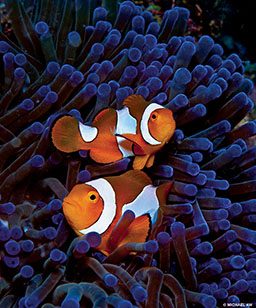
The management plan for the park established 14 tourism zones. To date, human impact is minimal, as there are only few tourists per year and around 20,000 inhabitants. It’s possible to travel the entire length and breadth of the park and see only a few locals. Modern developments are almost nonexistent; there is no water sports center, Four Seasons or Hilton. But on the geological time scale, massive changes have occurred over the millennia.
Between 3 million and 14 million years ago, slivers of land moved by unstable tectonic plates sealed the mouth of Cenderawasih Bay. These obstructions prevented the spread of oceanic larvae into and out of the bay. Thus the marine life in the bay evolved in isolation. Although the barriers eventually broke open, the shallow sill and sheer size of the bay limit oceanographic circulation, preventing planktonic larvae from reaching many reefs in the bay.
Through the ages the inhabitants of Cenderawasih Bay swam in varying sea levels; fishes and coral species vanished and reappeared again. During the Pleistocene epoch, sea level plunged to 400 feet below where it is today. Inhabitants of the shallow reefs perished, and animals of the deep found themselves near the surface of the bay. As sea levels rose again, flooding the dried reef zone, these deepwater animals followed the rising sea to depths in the 6- to 65-foot range. Here these inhabitants enjoyed little competition due to the bay’s unique oceanographic properties, and deepwater species such as Burgess’ butterflyfish (Chaetodon burgessi), which are normally associated with depths of 200 to 260 feet, are commonly found here as shallow as 33 feet.
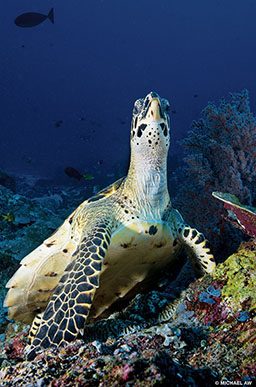
Marine scientists have established that until recent times the bay was geologically isolated from the flow of the Pacific tides. This isolation consecrated Cenderawasih as an ancient sea with a high percentage of endemic fish and coral species found nowhere else on the planet. Ichthyologist Gerald Allen, Ph.D., a consultant for Conservation International, proclaimed the bay “the Galápagos of the East” based on documented findings of an “evolutionary cauldron” of new and unique corals, shrimps and fishes. Extensive surveys documented 995 species of fish and more than 500 species of corals — approximately 10 times as many as the entire Caribbean. Lured by the prospect of new discoveries, I made seven sojourns to this primordial sea in the last six years.
There is something decidedly adventurous and exciting about flying through five airports in three days, hopping from a ginormous Singapore Airlines double decker Airbus A380 to an Xpress Air 18-seat turboprop, arriving in Nabire and being promptly whisked away to a quaint harbor beside a raucous fish market. My first expedition was arranged by a local fixer and used police boats and Navy dive gear. In subsequent expeditions I traveled on a modern liveaboard.
Although my primary agenda was exploring sites that had not been seen before and capturing pictures of deepwater animals in shallow water, the major attraction at Cenderawasih is the congregations of whale sharks (Rhincodon typus) in the southern part of the reserve. While there are a number places in the world where whale sharks congregate, such as the Galápagos, Belize, Western Australia’s Ningaloo Reef and Donsol in the Philippines, the sharks are resident in those places for only one to three months before they move away. The fishermen in Cenderawasih say that the bay’s whale sharks visit their fishing platforms throughout the year.
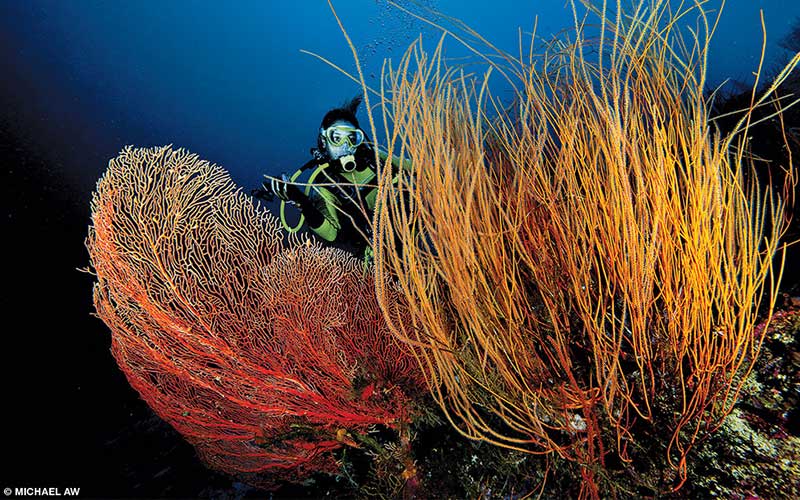
My exploration of this enchanting and unspoiled outpost of Indonesia began with navigational charts, a 2010 Rapid Marine Biological Assessment report by Mark Erdmann, Ph.D., and coordinates taken from Diving Indonesia’s Bird’s Head Seascape (Jones and Shimlock, 2011). Over the vastness of the atoll I explored layers upon layers of mighty plate corals in immaculate condition; the reef tops are adorned with some of healthiest hard-coral meadows I have ever seen. The outside reefs comprise dramatic vertical walls rich with sea whips and colorful sponges. We found pockets of severely damaged reef, which might have been casualties of dynamite fishing or coral-bleaching events. Many of these areas were in various stages of recovery, scattered with youthful colonies of staghorn corals.
Before we came we were told to expect low fish biomass. Fish density was indeed low at a few sites, but we repeatedly encountered massive schools along ridges, especially where tidal or ocean currents converged. One afternoon, while shooting a panorama of a field of hard corals, I looked up to see damselfishes congregating for an evening spawning session. There must have been a gazillion of them. Spellbound, I stayed until I’d nearly breathed my tank dry.
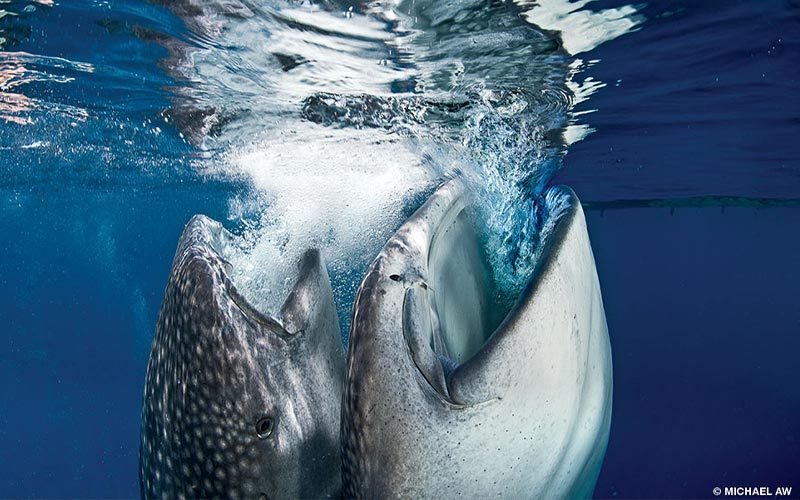
On the days we spent exploring the atoll and fringing reefs, we continued to find healthy coral; most of the sites we documented were populated by intact hard corals that stretched indefinitely along fringing reef slopes. Although we spotted only two sharks, we recorded several species of reef fish, including barracuda, eagle rays and several green and hawksbill turtles. A park ranger was on board telling us about past sightings of dugongs and saltwater crocodiles. I was delighted to capture images of a few endemic species: a Cenderawasih fairy wrasse, Cenderawasih fusiliers and a new species of longnosed butterflyfish. I found the usually deep-water Burgess’ butterflyfish in just 33 feet of water.
Burt Jones, principal photographer for Conservation International’s Cenderawasih Bay expedition, told us to not expect colorful soft-coral foliage like that of the Maldives or Raja Ampat, but one afternoon while in search of a site for a night dive near the Napen Peninsula we found a Solomon’s mine of soft corals. It was a submerged ridge complex comprising two tiny islets and three rocky outcrops that barely broke the surface of the sea. Underwater, the terrain was a hodgepodge gallery of estranged artists: Works similar to Van Gogh, Monet and Picasso were on display. We found orange, red and yellow whip corals in hefty bushes, while bright tunicates blossomed like Chinese New Year plants. Lavish soft-coral coverage seemed to defy gravity. It was utterly out of proportion and out of place; the phantasmagoria was a scene straight out of a Lewis Carroll story. I named the site Dr. Seuss Reef.

Any exploration of Cenderawasih would not be complete without at least three days of interaction with the resident whale sharks. Only in recent years did we become aware of whale sharks frequenting the local fishing platforms (bagans). The fishermen told us that the sharks have been around their bagans since they began operating in the bay some 25 years ago.
About 23 of these semimobile platforms are located around Kwatisore Bay at the southern end of the park. At dusk fishermen lower massive nets beneath the platforms to about 60 feet deep. Floodlights on the surface illuminate the water to attract millions of ikan puri, three-inch-long baitfish. Fishermen raise the nets in the morning, bringing up tons of the fish, some of which will be collected and used as bait for bonito fishing. The rest of the baitfish remain in the net, hanging just beneath the platform. Whale sharks in the bay have learned to suck these small fishes from the nets. The fishermen feed bucketloads of ikan puri to the sharks, which we now know are opportunistic feeders that can associate humans with food. Cenderawasih Bay is the first location in the world in which such whale-shark behavior has been documented.
On our 2015 expedition we encountered 13 individual whale sharks beneath just one of the bagans. We started early each morning and seldom finished before dusk. Typical of sharks, lions and humans, prime feeding times were the in the morning and just before dusk. At 7 a.m. we usually saw two or three juveniles placidly sucking from the net, but by 10 a.m., eight animals, ranging from 7 feet to 40 feet, would congregate to feed from the nets or receive handouts from the fishermen. Noon was a lull period; only a couple of juveniles would still be hanging around for more handouts. At about 4 p.m. the crepuscular rays radiating through the water acted as a dinner bell. The sharks disregarded all table manners, frantically rushing in with mouths agape, climbing atop one another with great urgency, taking in as much food as possible before nightfall.
Throughout the four days we spent with these sharks, all members of our expedition were able to approach them closely and make eye contact on both snorkel and scuba. They were gentle and appeared to move their powerful tails so as to avoid hurting divers. Seemingly unopposed to our presence, some actually rose vertically alongside us to pose with the clumsy bubble-blowers.
At one point I was photographing three sharks as they confronted fishermen on the bagan for more food. Unbeknownst to me, two bigger sharks approached the bagan from behind me. I felt a push, and in the next moment I was like ham between bread, sandwiched between five animals, each of which weighed around 15 tons. It was a sloppy moment, with colossal fleshy mouths all around me, but the sharks were gentle, and I managed to escape from among them. I was flabbergasted, and my grin was as wide as a whale shark’s mouth.
We know that whale sharks rise to the surface to feed on plankton and small fish, but there is much we don’t know about them. The biggest fish in the ocean, they breathe with gills and are ectothermic (cold-blooded), preferring to swim in warm waters. We are unsure if the Cenderawasih population is local, but if the shark-fin merchants were to move in, all the animals in the bay could be harvested in just a couple of weeks. To better understand the migratory patterns of these sharks, Erdmann led Conservation International expeditions to tag some of them. (Learn more at Conservation.org.) The tags revealed that the sharks are not permanent residents of the bay, but some return each year.
The tagging exercise is an important effort to learn more about these awesome animals: where and how they mate, how they spend their early years and other mysteries. The tags may or may not provide some answers, but the primary concern is learning how to better protect them and their habitat for future generations.
We termed Cenderawasih Bay a global treasure. Ocean conservationist and diving legend Valerie Taylor has an even better description: the eighth natural wonder of our world. Cenderawasih is an embodiment of nature’s beauty that fans our fervor to protect and preserve.
How to Dive It
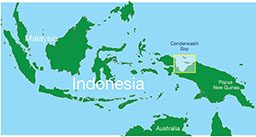
Getting There: Established in 1993 by the Republic of Indonesia, the Cenderawasih Bay National Park covers 5,612 square miles in the southwest quarter of Cenderawasih Bay, West Papua. It can be accessed by sea from the towns of Manokwari and Nabire, which lie 60 miles north and 25 miles northeast, respectively. Flights are available to Manokwari, Biak and Nabire.
Conditions: The weather is commonly rainy and stormy from February through May; the best time to dive is July through November. Whale sharks are resident year round. Air and water temperatures are commonly in the mid-80s°F, and most dives are between 80 and 130 feet. Tidal currents can be encountered on atoll and reef sites, but conditions are reliably mild where the whale sharks are found.
Hyperbaric Chamber: The nearest hyperbaric facilities that treat divers are in Raja Ampat (West Papua, Indonesia), Manado (North Sulawesi, Indonesia) and Darwin, Australia.
© Alert Diver — Q1 Winter 2016